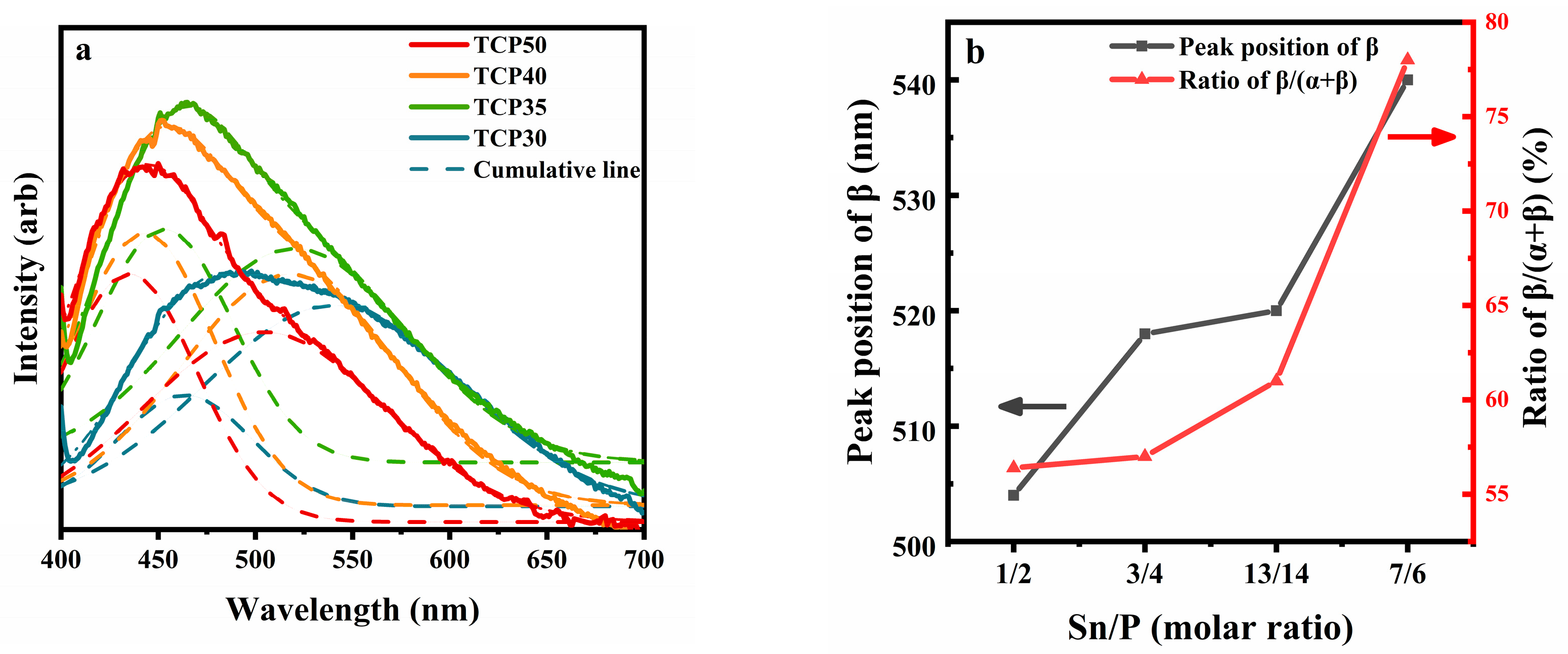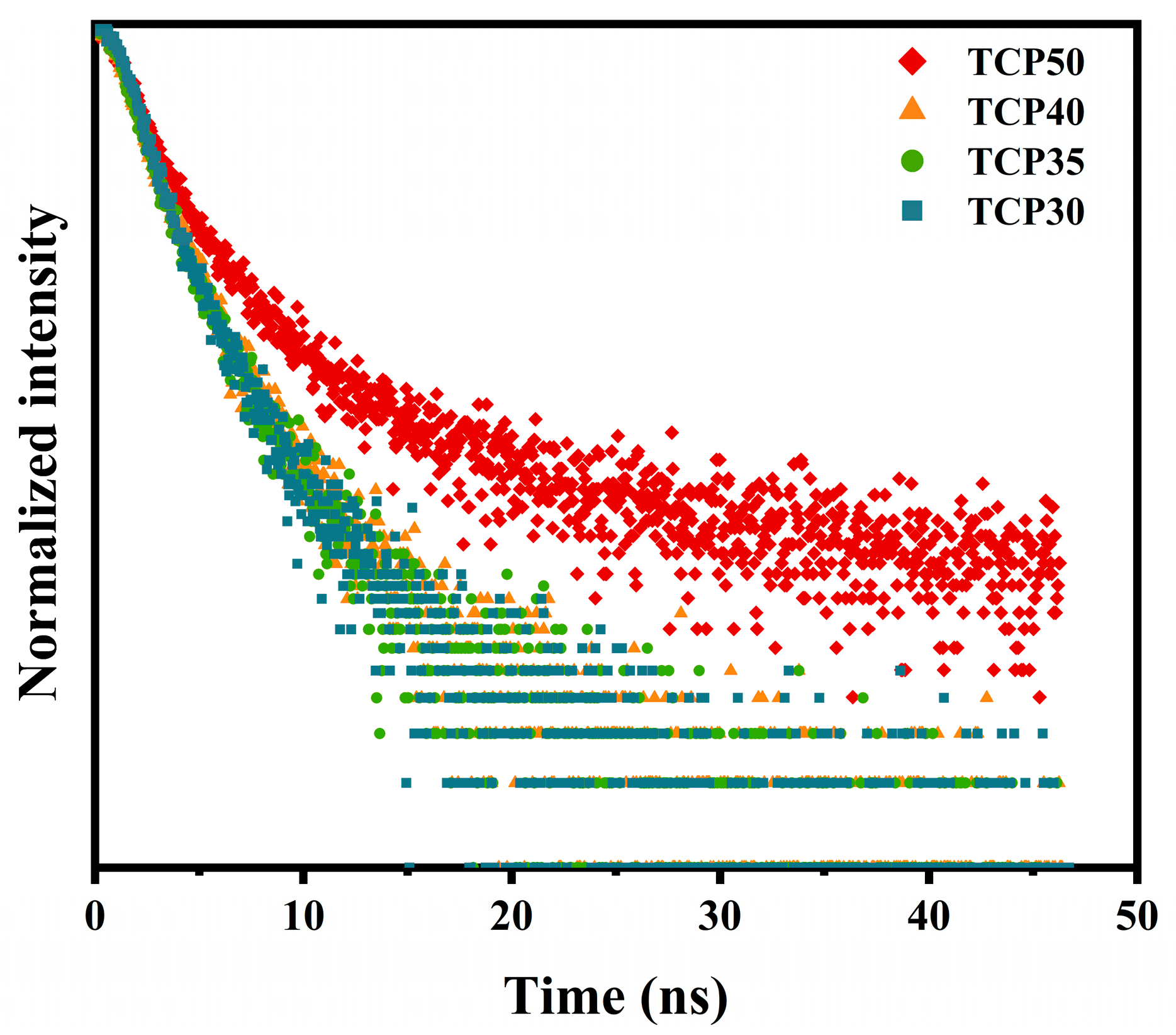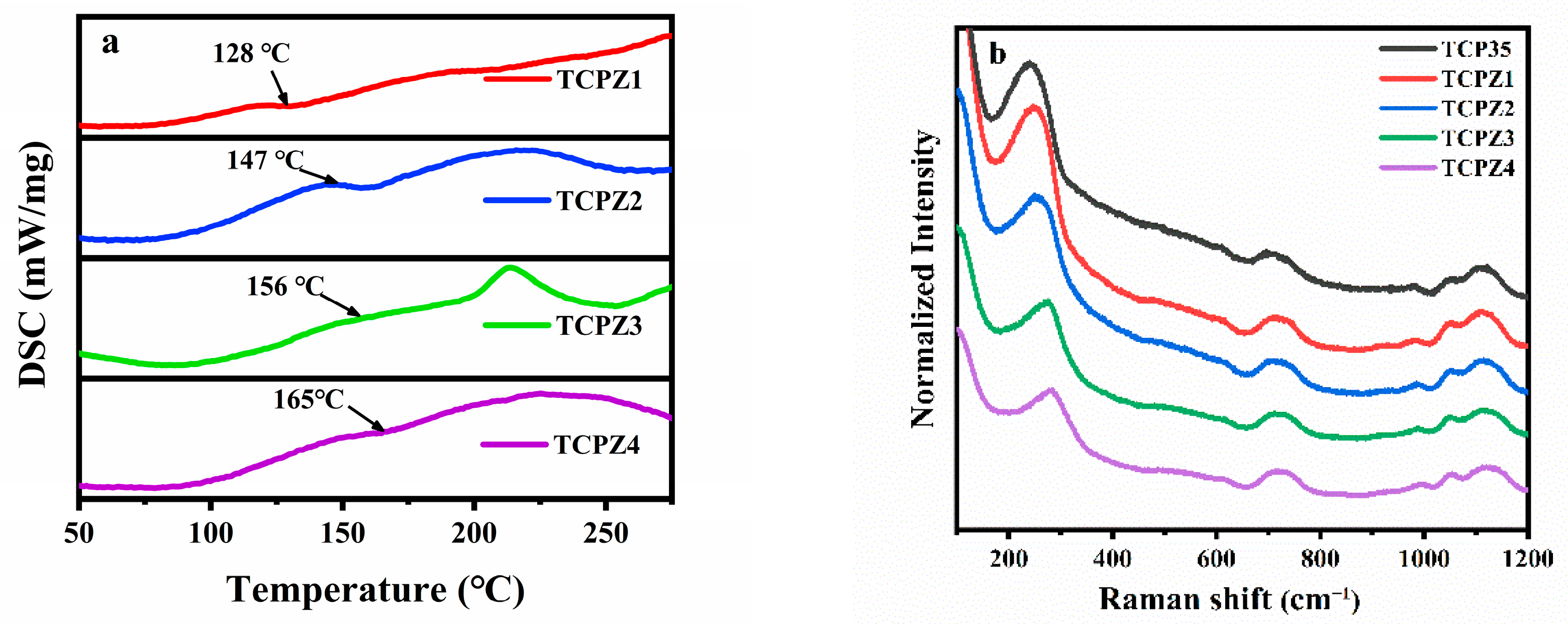ZnCl2-Enhanced Intrinsic Luminescence of Tin Chlorophosphate Glasses
Abstract
1. Introduction
2. Materials and Methods
2.1. Sample Preparation
2.2. Characterization
3. Results and Discussion
3.1. Spectral Properties of Binary TCP Glasses
3.2. Spectral Properties of Ternary P2O5-SnCl2-ZnCl2 Glasses
4. Conclusions
Author Contributions
Funding
Institutional Review Board Statement
Informed Consent Statement
Data Availability Statement
Conflicts of Interest
References
- Nakanishi, T.; Tanabe, S. Novel Eu2+-Activated Glass Ceramics Precipitated with Green and Red Phosphors for High-Power White LED. IEEE J. Sel. Top. Quantum Electron. 2009, 15, 1171–1176. [Google Scholar] [CrossRef]
- Yoo, H.; Kouhara, Y.; Yoon, H.C.; Park, S.J.; Oh, J.H.; Do, Y.R. Sn-P-F containing glass matrix for the fabrication of phosphor-in-glass for use in high power LEDs. RSC Adv. 2016, 6, 111640–111647. [Google Scholar] [CrossRef]
- Karadza, B.; Van Avermaet, H.; Mingabudinova, L.; Hens, Z.; Meuret, Y. Efficient, high-CRI white LEDs by combining traditional phosphors with cadmium-free InP/ZnSe red quantum dots. Photonics Res. 2022, 10, 155–165. [Google Scholar] [CrossRef]
- Masai, H.; Takahashi, Y.; Fujiwara, T.; Matsumoto, S.; Yoko, T. High Photoluminescent Property of Low-Melting Sn-Doped Phosphate Glass. Appl. Phys. Express 2010, 3, 082102. [Google Scholar] [CrossRef]
- Masai, H.; Fujiwara, T.; Matsumoto, S.; Takahashi, Y.; Iwasaki, K.; Tokuda, Y.; Yoko, T. White light emission of Mn-doped SnO-ZnO-P2O5 glass containing no rare earth cation. Opt. Lett. 2011, 36, 2868–2870. [Google Scholar] [CrossRef] [PubMed]
- Masai, H.; Tanimoto, T.; Fujiwara, T.; Matsumoto, S.; Tokuda, Y.; Yoko, T. Correlation between emission property and concentration of Sn2+ center in the SnO-ZnO-P2O5 glass. Opt. Express 2012, 20, 27319–27326. [Google Scholar] [CrossRef]
- Zhang, T.J.; Zhou, C.C.; Lin, J.; Wang, J. Effects on the emission discrepancy between two-dimensional Sn-based and Pb-based perovskites. Chin. Opt. Lett. 2022, 20, 021602. [Google Scholar] [CrossRef]
- Wang, Y.J.; Yu, Y.; Zou, Y.; Zhang, L.Y.; Hu, L.L.; Chen, D.P. Broadband visible luminescence in tin fluorophosphate glasses with ultra-low glass transition temperature. RSC Adv. 2018, 8, 4921–4927. [Google Scholar] [CrossRef]
- Wang, Y.J.; Li, Y.; Han, S.; Zhang, L.Y.; Chen, D.P. Continuously tunable broadband emission of Mn2+-doped low-melting point Sn-F-P-O glasses for warm white light-emitting diodes. J. Am. Ceram. Soc. 2018, 101, 5564–5570. [Google Scholar] [CrossRef]
- Mao, W.; Cai, M.Z.; Xie, W.Q.; Li, P.P.; Zhen, W.Y.; Xu, S.Q.; Zhang, J.J. Tunable white light in trivalent europium single doped tin fluorophosphates ultra-low melting glass. J. Alloys Compd. 2019, 805, 205–210. [Google Scholar] [CrossRef]
- Wang, R.; Zhang, J.H.; Zhang, Y.J.; Lin, H.; Pun, E.Y.B.; Li, D.S. Phosphor-in-glass with full-visible-spectrum emission based on ultra-low melting Sn-F-P-O glass pumped by NUV LED chips. J. Alloys Compd. 2021, 864, 158671. [Google Scholar] [CrossRef]
- Jiang, S.B.; Luo, T.; Wang, J.F. Spectral properties of organic chromophores in fluorophosphate glasses. J. Non-Cryst. Solids 2000, 263, 358–363. [Google Scholar] [CrossRef]
- Wu, T.; Wang, C.; Shen, Y.; Du, Y.; Tao, Y.; Wang, P.; Chen, D. Preparation and structure of low-melting-point stannous chlorophosphate containing nitrogen glasses. J. Non-Cryst. Solids 2022, 591, 121739. [Google Scholar] [CrossRef]
- Skuja, L. Isoelectronic Series of Twofold Coordinated Si, Ge, and sn Atoms in Glassy SIO2—A Luminescence Study. J. Non-Cryst. Solids 1992, 149, 77–95. [Google Scholar] [CrossRef]
- Masai, H.; Yamada, Y.; Suzuki, Y.; Teramura, K.; Kanemitsu, Y.; Yoko, T. Narrow Energy Gap between Triplet and Singlet Excited States of Sn2+ in Borate Glass. Sci. Rep. 2013, 3, 3541. [Google Scholar] [CrossRef] [PubMed]
- Shen, C.; Ou, Y.; Qin, G.; Chen, G.; Baccaro, S. Optical properties of phosphate glass containing SnO2. Glass Technol. -Eur. J. Glass Sci. Technol. Part A 2010, 51, 213–215. [Google Scholar]
- Mao, W.; Xie, W.Q.; Li, P.P.; Lu, Y.; Duan, Y.M.; Xu, S.Q.; Zhang, J.J. Double relaxation emission of Sn2+ activator in tin fluorophosphate glass for device applications. Chem. Eng. J. 2020, 399, 125270. [Google Scholar] [CrossRef]
- Masai, H.; Fujiwara, T.; Matsumoto, S.; Takahashi, Y.; Iwasaki, K.; Tokuda, Y.; Yoko, T. High efficient white light emission of rare earth-free MnO-SnO-ZnO-P2O5 glass. J. Ceram. Soc. Jpn. 2011, 119, 726–730. [Google Scholar] [CrossRef]
- Torimoto, A.; Masai, H.; Okada, G.; Yanagida, T. X-ray induced luminescence of Sn2+-centers in zinc phosphate glasses. Radiat. Meas. 2017, 106, 175–179. [Google Scholar] [CrossRef]
- Hudgens, J.J.; Brow, R.K.; Tallant, D.R.; Martin, S.W. Raman spectroscopy study of the structure of lithium and sodium ultraphosphate glasses. J. Non-Cryst. Solids 1998, 223, 21–31. [Google Scholar] [CrossRef]
- Zhang, L.Y.; Li, H.; Hu, L.L. Statistical structure analysis of GeO2 modified Yb3+: Phosphate glasses based on Raman and FTIR study. J. Alloys Compd. 2017, 698, 103–113. [Google Scholar] [CrossRef]
- Thuat, N.T.; An, N.M.; Nguyen, K.D.; Nguyen, T.D.; Truong, T.T. Synthesis of organo tin halide perovskites via simple aqueous acidic solution-based method. J. Sci. Adv. Mater. Devices 2018, 3, 471–477. [Google Scholar] [CrossRef]
- Moreira, E.; Henriques, J.M.; Azevedo, D.L.; Caetano, E.W.S.; Freire, V.N.; Albuquerque, E.L. Structural, optoelectronic, infrared and Raman spectra of orthorhombic SrSnO3 from DFT calculations. J. Solid State Chem. 2011, 184, 921–928. [Google Scholar] [CrossRef]
- Jain, D.; Sudarsan, V.; Vatsa, R.K.; Pillai, C.G.S. Luminescence studies on ZnO–P2O5 glasses doped with Gd2O3:Eu nanoparticles and Eu2O3. J. Lumin. 2009, 129, 439–443. [Google Scholar] [CrossRef]
- Djurisic, A.B.; Leung, Y.H.; Tam, K.H.; Ding, L.; Ge, W.K.; Chen, H.Y.; Gwo, S. Green, yellow, and orange defect emission from ZnO nanostructures: Influence of excitation wavelength. Appl. Phys. Lett. 2006, 88, 103107. [Google Scholar] [CrossRef]






| Sample | Emission Peak Position (nm) | Fluorescence Decay (ns) | β/ (α + β) (%) | |
|---|---|---|---|---|
| α-Band | β-Band | |||
| TCP50 | 435 | 504 | 2.61/20.03 | 56.4% |
| TCP40 | 444 | 518 | 2.39 | 57% |
| TCP35 | 452 | 520 | 2.30 | 61% |
| TCP30 | 463 | 540 | 2.37 | 78% |
Publisher’s Note: MDPI stays neutral with regard to jurisdictional claims in published maps and institutional affiliations. |
© 2022 by the authors. Licensee MDPI, Basel, Switzerland. This article is an open access article distributed under the terms and conditions of the Creative Commons Attribution (CC BY) license (https://creativecommons.org/licenses/by/4.0/).
Share and Cite
Wu, T.; Tao, Y.; Wang, P.; Zhao, M.; Chen, D. ZnCl2-Enhanced Intrinsic Luminescence of Tin Chlorophosphate Glasses. Photonics 2022, 9, 973. https://doi.org/10.3390/photonics9120973
Wu T, Tao Y, Wang P, Zhao M, Chen D. ZnCl2-Enhanced Intrinsic Luminescence of Tin Chlorophosphate Glasses. Photonics. 2022; 9(12):973. https://doi.org/10.3390/photonics9120973
Chicago/Turabian StyleWu, Ting, Yiting Tao, Panting Wang, Mingjun Zhao, and Danping Chen. 2022. "ZnCl2-Enhanced Intrinsic Luminescence of Tin Chlorophosphate Glasses" Photonics 9, no. 12: 973. https://doi.org/10.3390/photonics9120973
APA StyleWu, T., Tao, Y., Wang, P., Zhao, M., & Chen, D. (2022). ZnCl2-Enhanced Intrinsic Luminescence of Tin Chlorophosphate Glasses. Photonics, 9(12), 973. https://doi.org/10.3390/photonics9120973





